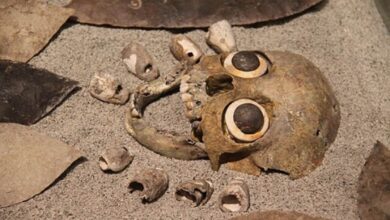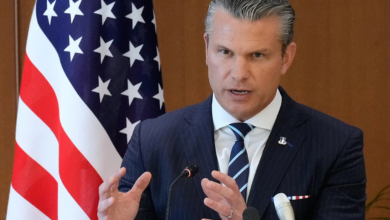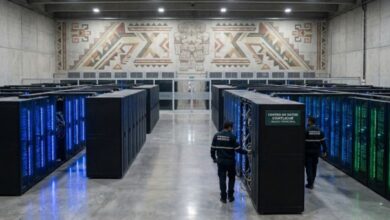Mexico’s Virgin of Guadalupe Lights Madrid and Bridges Centuries of Shared Faith
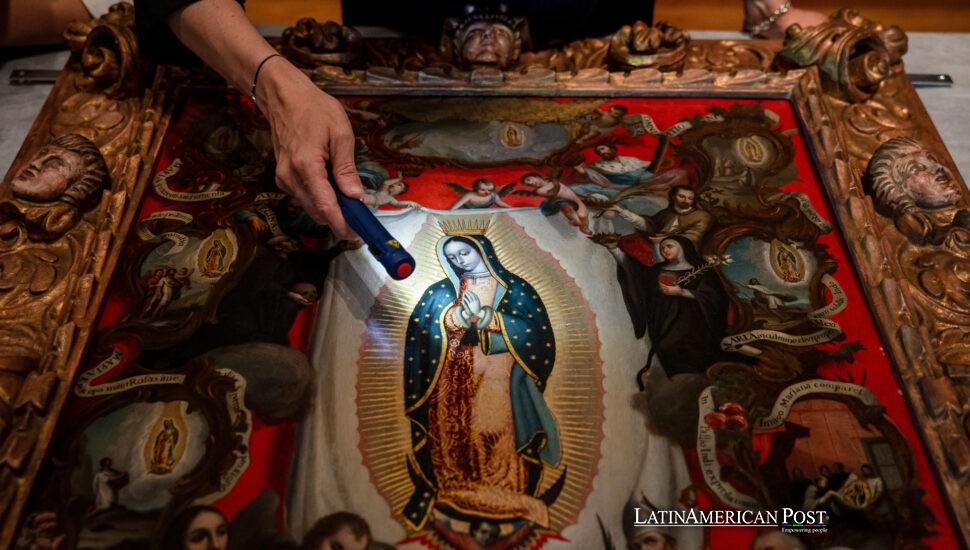
Madrid’s Prado has never smelled quite like this: cedar crates, fresh varnish, and a whiff of copal incense mingle as curators assemble the first exhibition devoted entirely to Mexico’s Virgin of Guadalupe—an ambitious reunion of artworks scattered across two continents for 500 years.
A Transoceanic Chapel Takes Shape
On a May dawn long before visitors queued for tickets, the Prado’s loading bay buzzed like a backstage opera. Forklifts beeped, conservators barked measurements, and couriers guarded crates stamped Catedral de Sevilla or Basílica de Guadalupe. For curator Jaime Cuadriello, the mission felt almost liturgical: transform two grand galleries into “a transoceanic chapel” where seventy Guadeloupian treasures could speak across centuries.
Each piece had traveled a path as complicated as any pilgrim’s. Enconchados—paintings studded with mother-of-pearl—left Mexico City in climate-controlled jets. At the same time, a six-foot processional banner from Burgos required a custom crate and police escort through Madrid’s snarled traffic. Under skylights muted to Tepeyac twilight, carpenters erected walls washed in Talavera blue. Lighting technicians adjusted LEDs to the precise kelvin that would make gold leaf glow like a sunrise but spare fragile pigments the scorch of modern bulbs.
When EFE reporters slipped in for a preview, they found Giovana Jaspersen from the Franz Meyer Museum squinting at a tiny shell-inlay icon no bigger than a postcard, confirming every nacre chip survived the flight. Nearby, restorer Álvaro Fernández hovered as riggers lifted a colossal Jerez de la Frontera canvas he had spent two months liberating from soot. “Polishing this felt like wiping dust off someone’s private prayer,” he whispered, palms still jittery as the hydraulic lift locked the frame.
Copies, Miracles, And the Peril of Repetition
Staging dozens of near-identical Virgins risks monotony, co-curator Paula Mues admits, but each object carries its passport of devotion. A pocket-sized ivory once hung from a conquistador’s rosary; a copper engraving rode Manila galleon to the Philippines; a miniature enconchado, bright as fish scales, comforted sailors crossing the Atlantic. In New Spain, such verídicas—”truthful copies” painted under strict workshop protocols—earned reputations as reliable conduits of grace. Families mailed them to Spanish relatives the way we might send baby photos, proof that Mexico’s new miracle could cross water undiluted.
Those shipments seemed to be a quiet revolution. By 1800, nearly a thousand Guadeloupian images studied Spanish churches from Cádiz to Coruña, naturalizing a Mexican icon into Iberian stone. The show tracks diffusion-like constellations on a maritime chart: Mexican originals hang beside Spanish reinterpretations, their differences subtle as a dialect—brighter carnations here, a stiffer crescent moon there. Together, they map an early form of globalization driven not by muskets or silver but by shared wonder at a brown-skinned Madonna who spoke Nahuatl to a peasant named Juan Diego.
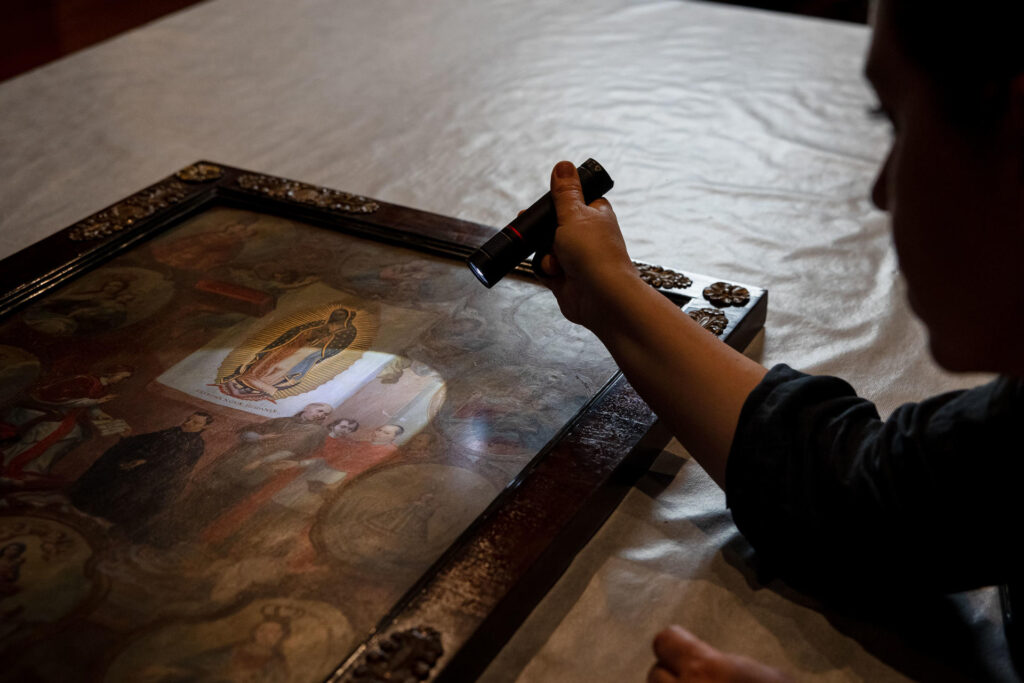
Unpacking Faith Under X-Ray Light
Behind velvet ropes visitors never see, the museum’s science wing whirred for months. Infrared cameras peeled back repaints, revealing thumbnail sketches beneath finished oils. X-ray scans of an enconchado panel exposed a carpenter’s repair from 1692—two tiny butterfly wedges hammered into the cedar to stop a crack before varnish sealed the wood forever. “Every fix is a historical heartbeat,” Fernández explains. One badly darkened canvas, under ultraviolet, erupted in speckles of lost ultramarine. Conservators filled losses with reversible glazes, careful not to over-restore; they want viewers to feel centuries, not erase them.
Even logistics carried spiritual stakes. Cathedral loans travel with appointed “courier clerics”: priests in collar and travel blazers verifying chain-of-custody forms at each airport. When a customs officer probed too close to a jewel-studded reliquary, Father José from Seville murmured, “Easy, she’s old,” as if calming an anxious grandmother. Across the Atlantic, Mexican counterparts performed similar vigils, blessing crates before forklifts rolled them onto cargo pallets.
The cooperation defies a climate where cultural patrimony often triggers diplomatic fistfights. Spain’s cathedrals waived hefty insurance fees; Mexico’s National Institute of Anthropology fast-tracked export permits usually snarled by red tape. The result, Mues says, is “a dialogue rather than an extraction”—a rarity in museum politics.
A Pilgrimage Without Leaving Madrid
Opening day lands during Madrid’s June fiesta season, and the line snaking along the Carrera de San Jerónimo looks more like a procession than a museum queue. Inside, hushed school groups pass a glass case holding one of the smallest pieces: a rough copper engraving stained by sweat where generations kissed the Virgin’s mantle. Nearby, a six-foot oil from Puebla commands a whole wall, its turquoise blues vibrant as a hummingbird’s throat. People cross themselves. Others stare, surprised that an image born in the Mexican highlands feels instantly familiar.
Audio guides narrate Guadalupe’s 1531 apparition, but the rooms tell a concurrent story: of sailors hugging icons as talismans against shipwreck, nuns stitching silver lilies under candlelight, and Indigenous artisans embedding seashell shards to mimic celestial light. Time-lapse video loops in a side alcove: swabs nip away grime, gold leaf regains its flash, and cracks knit under a conservator’s steady hand. Viewers watch centuries rewind in eight hypnotic minutes.
Visitors exit past a wooden sculpture of Sor María de Jesús de Ágreda, the seventeenth-century mystic who claimed to bilocate from Spain to New Mexico deserts to preach to Indigenous tribes. The curators placed her last for a reason: she embodies spiritual travel without ships, reminding modern audiences that images—and ideas—span oceans even when bodies cannot.
Outside, banners ripple on lampposts: the Virgin’s cloak rendered in broad turquoise stripes. Market stalls nearby sell tlayudas next to churros, a culinary handshake echoing the art inside. One elderly madrileño emerges from the museum, wiping tears. “Nunca he estado en México,” he murmurs, “pero hoy la Virgen ha venido a mí.” I have never been to Mexico, but the Virgin came to me today.
Also Read: Mexican Television Pioneer Chespirito Inspires Fresh Biographical Series
For anyone who has slipped a family photo into a suitcase and prayed it would survive the journey, the exhibition’s title So far so close resonates like a benediction. Across five centuries and two oceans, these images prove that distance can stretch faith but never break it. In the Prado’s softly lit chapel of borrowed treasures, Spanish and Mexican visitors rediscover a shared inheritance that feels miraculously whole, if only for a summer.

